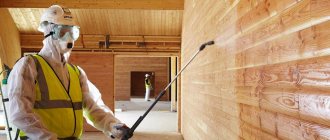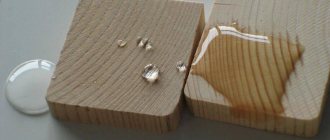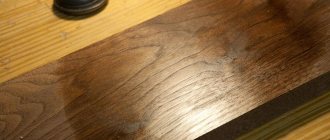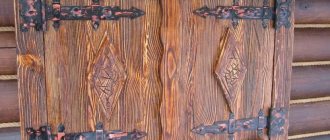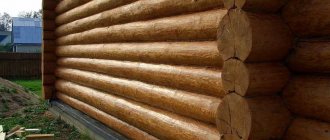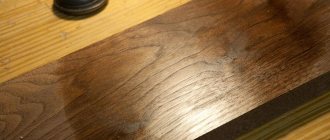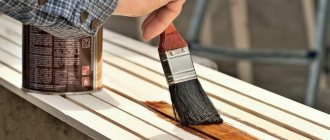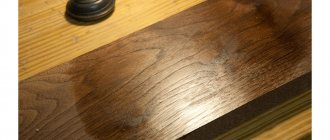What are fire retardants used for?
First you need to understand why wood is exposed to fire. It consists of fibers soaked in water. The fibers are of organic origin, so they burn when exposed to flame. As a result of direct thermal contact, the structure of the material is dehydrated almost instantly, and a large amount of oxygen is released. Further, during the smoldering process of the fibers, wood gas is released, which ignites when interacting with hot air. As a result of these processes, the tree burns.
Fire retardants are used to improve the fire resistance of wood. The compositions have a simple principle of action:
- As a result of the interaction of fire retardants with hot air, persistent gaseous compounds are formed that cool the surface.
- Next, a charred layer is formed, which prevents the penetration of oxygen deep into the wood.
Fire retardant treatment of wood gives materials fire-resistant properties. The tree acquires protection from the effects of fire both outside and inside. But when choosing a composition, you need to distinguish between classes of fire retardants, as well as the characteristics of the components of a particular product.
Types of fire retardant impregnations
There are three basic types of materials for fireproofing of wooden structures:
- alkaline;
- saline;
- acidic.
They are represented by special fire retardants, paints, enamels, varnishes and other compounds for surface protection of wood from fire.
Fire retardants
A fire retardant is a fire retardant chemical composition that slows down the possible ignition and burning of wood.
The following types of fire retardants are distinguished:
- water soluble;
- organosoluble.
Water-soluble fire retardants are the most popular and safe option for increasing the fire resistance of wooden structures that are not subject to prolonged exposure to moisture. They are intended to protect residential buildings and commercial buildings.
Water-soluble impregnations are:
- easy to wash;
- washable;
- non-washable;
- difficult to wash out.
Organosoluble-based flame retardants are deep penetration compounds that are resistant to high humidity and temperature changes. The presence of highly flammable components is the main disadvantage of fire retardants, which are used only for fire protection of industrial structures.
Fire retardant paints
Paints for protection against ignition and fire are used for external and internal processing of wood. Materials can be applied by hand with a roller or by airless spraying using a spray gun.
Fire retardant paints for processing wooden structures are divided into two types:
- Intumescent - compositions of the 1st group of protection efficiency, which during the combustion process release gas and water, strengthening the fire-resistant protective layer. The thickness of the swollen base increases from 8 to 30 times. The use of intumescent paints increases the fire resistance class of wood to G1 (low-burning surfaces) and G2 (moderate-burning surfaces).
- Non-intumescent - compositions containing liquid glass and fire retardant components. Treatment with such paints allows you to raise the class of wood to G1 and G2, respectively.
According to their intended purpose, fire retardant paints are divided into the following categories:
- facade compositions;
- compositions for internal processing.
Fire retardant varnishes
This type of paint and varnish material is used to decorate wood. In addition, varnishes can increase the fire resistance of wood while preserving its natural structure and attractive appearance. They come in matte and semi-matte finishes.
Fire-retardant varnishes are suitable for processing individual structural elements, walls, floors, furniture and other materials.
The main advantages of varnishes include the following:
- possibility of application to pre-treated wood (for which no water-dispersible agents were used);
- painting work can be carried out at air temperatures from +6 degrees;
- each subsequent layer of varnish is applied 12 hours after the previous treatment;
- simplicity and accessibility of application using convenient painting tools.
Other fire retardants
In addition to paints and varnishes, structural compounds can be used to increase the fire safety of wooden surfaces.
Fire protection for wood includes:
- gypsum fiber sheets (GVL). The non-combustible material is suitable for creating fire-resistant structures that reduce the thermal effect on wood. GVL are in demand in cases where it is impossible to use other types of protection;
- roll materials. For additional fire protection, foil insulation can be used, which is suitable for installation in hard-to-reach places or enclosed spaces;
- fire resistant belts. Special materials for creating protective screens that prevent the spread of open fire in wooden structures. The use of fire-resistant belts requires preliminary development of the project and drawing up a technological map indicating the necessary measures to protect the wood;
- auxiliary protective equipment. These can be brick or metal frames, heat-resistant plaster based on vermiculite.
Types of fire retardants for wood
The main indicator characterizing the degree of fire protection for wood treated with protective compounds is the fire resistance class. Modern materials are used as antiseptics. According to GOST R 53292-2009, fire-resistant treatment is divided into two groups:
- First. Wood treated with the composition must be completely protected from fire - in direct contact with the flame, with a relatively small thermal effect.
- Second. Recommended for use in the formation of fire protection. If the time of direct exposure to flame is exceeded, the tree begins to burn.
Such means should not affect changes in the properties of wood, from mechanical strength to thermal conductivity. As a means of additional protection, such coatings can prevent the formation of fungi. Certain species make it possible to create protection against woodworms. To choose the optimal protective agent, familiarize yourself with the main types of fire retardants. They differ in release form. Boron-based compositions are designed to create effective fire protection in combination with other components. With the help of such products, deep impregnation and resistance to water interaction are ensured. Urea phosphate-based materials make wood resistant to open flames. Improving the quality characteristics of the product is possible by adding orthophosphoric acid to the composition.
DIY fire retardant
The fire retardant has a simple composition that you can repeat yourself. In addition, all substances comply with the requirements of regulatory documentation:
- Protects wood from fire for 15 minutes.
- No corrosive effect on metal.
- Does not deform wood (no cracks, scratches).
- No negative impact on human health.
The most popular fire retardant that you can prepare with your own hands is a 40% potash solution. It contains potassium carbonate and potassium carbonate.
You can also use a solution containing:
- water;
- lime: 75 parts;
- clay: 15 parts;
- salt: 10 parts.
A solution based on 95 parts water, borax (2 parts) and boric acid (3 parts) is often used.
To prepare fire retardant yourself, you need a special container or a regular bucket. For protection, it is recommended to prepare the solution wearing rubber gloves and a respirator.
Making your own fire retardant for wood eliminates the possibility of purchasing counterfeit products that can be found in stores. But cooking it with your own hands is not safe. The components have a toxic effect on the human body. Self-prepared solutions are usually short-lived. To ensure fire protection of the material, they will need to be applied several times a year.
What are the types of fire retardants?
To select the right contractor who has a thorough understanding of low-rise building codes, search the Building Companion directory.
The profile of each company contains the necessary information, portfolio, reviews, and you can place a request for an estimate of the cost of the service. Find a general contracting and construction supervision company » Means for protecting lumber from burning differ according to various criteria. This fire protection is available on the market in different forms:
- Paste. Paste-type inhibitors provide reliable protection of the structure from flames. However, they have an unaesthetic appearance. According to this characteristic, mastics and pastes are inferior to paintwork. Due to this feature, they are used to treat surfaces that are not in visible places.
- Varnish. Such inhibitors are popular due to their ease of use. A thin layer of varnish is easily applied to the surface of the material. In addition to imparting protective properties from exposure to open flames, lumber becomes resistant to rot and moisture. The paint can have any color, and the varnish has a transparent structure.
- Impregnation. Inhibitors that provide reliable protection against exposure to open flames. However, their use can cause certain inconveniences, unlike mastics and varnishes. To properly protect the material from fire, the wood must be pre-immersed in impregnation or treated under pressure. After this event, construction work can begin.
Combination-type formulations are also available on the market. They are applied one by one. Such products are reliable, unlike pastes, varnishes and impregnations. High reliability is achieved because the new layer eliminates the shortcomings of the previous one.
Contains halogens and phosphorus
Halogen-derived fire-resistant substances contain bromine or chlorine atoms and have a more or less negative effect on the environment.
In recent years, some European countries have introduced a ban on the use of drugs with halogens, due to the discovered possibility of transformation into dangerous carcinogens at high temperatures. Restrictions especially apply to fire retardants containing chlorine.
In some sources you can see arguments about the safety of using bromine-containing organics, compared to chlorinated compounds.
Bromo derivatives are less volatile, decompose in a small temperature range, provide better protection, and remain a frequently used flame retardant, especially for polymers.
https://youtube.com/watch?v=OVM64WBv1kk
Phosphorus-containing organic representatives of fire retardants can also contain halogen atoms, in most cases they belong to ethers and their derivatives.
When heated, some of these flame retardants release water vapor, which lowers the temperature of the environment and turns into polyphosphates, which protect the material from fire.
Other phosphorus-containing organics prevent combustion by evaporation and neutralize flame free radicals, similar to the effect of halogenated drugs.
Characteristics of fire retardants for wood
There are many requirements for such compositions. To provide effective fire protection, they must have certain properties:
- Inhibiting the combustion of materials, slowing down the smoldering process. The fire retardant must prevent the spread of open flames throughout the material. This occurs due to the formation of a heat-insulating layer, which swells under thermal influence.
- Prevents the formation of toxic products when exposed to extreme heat or fire.
- Reducing the volume of smoke emission during surface combustion of organic materials.
- The protective composition should not affect the load-bearing capacity of surfaces. The coating should not change the density of the lumber, its hardness, rigidity, or dielectric conductivity.
- Coatings should not provoke corrosion processes on the surface of metal structures.
- Coatings should not emit harmful substances to living organisms.
- Fire retardants should not change the appearance of materials.
- The protective agent must be chemically stable, which affects the durability of coatings, solutions and fire retardant additives.
- Increasing the resistance of materials to UV rays and climatic factors.
OS operating conditions
Wooden structures under specific operating conditions require fire-fighting treatment with certain substances:
- compositions for treating wooden structures operated in open space or under a canopy must take into account the local climate conditions. This concerns fluctuations in temperature, humidity level in a given area;
- coatings and impregnations for wood in unheated rooms. Fire retardants are used to treat wooden parts where, due to the confined space, changes in the temperature and humidity level of the surrounding air are insignificant;
- OS for heated rooms, closed spaces with an artificial microclimate. The compositions ensure fire safety of structures under conditions of constant positive temperature and air humidity level of about 70%.
Criteria for the effectiveness of fire protection
Fire protection of wood is divided into three categories of action:
- Preventing wood fire hazards.
- Decay of combustion at the initial stage.
- Passive localization of lesions.
Validity
The duration of the fire protection coating is influenced by various factors. If we are talking about water-soluble compounds used for treating interior coatings and not exposed to moisture, then they retain their characteristics for 3 years. The service life of protective pastes, paints, varnishes and combined fire retardants ranges from 5 to 7 years.
Any antiseptic product has a service life, after which the protection is reapplied. If the same drug is used for re-processing, then these formulations will be completely compatible. Otherwise, you need to evaluate how compatible the protective equipment is. This will prevent the risk of chemical reactions between different coatings.
Compositions and properties
Fire retardant properties of impregnations and other materials are provided by special protective substances, very often nitric acid, sulfuric acid and ammonium salts.
Under the influence of high temperature, a chemical reaction begins, as a result of which a layer of non-combustible material is formed on the surface of the wood. In addition, the chemical reaction is accompanied by the release of gases that prevent the wood from burning.
Phosphorus and halogen atoms are often used as a basis for creating organosoluble compounds. In the production of water-soluble impregnations, phosphate acids are used, including monoammonium, diammonium phosphate, etc.
High-quality impregnations do not harm wood and ensure that the technical characteristics of the material are maintained even in the event of a fire.
Fire retardant compounds will not be able to protect against arson committed using flammable solutions.
Fire retardant wood treatment - features
There are different ways to use fire retardants. Common solutions:
- Surface impregnation technology.
- Cold/hot bath soaking method.
- Autoclave processing method.
Surface impregnation is a popular method of applying fire retardants to the surface of wooden coverings. To apply the antiseptic, a sprayer, roller or brush is used, so it is excellent for domestic use. This is labor-intensive and in order to create the necessary level of fire protection, you need to apply the composition in several layers.
To select the right home builder for your desired low-rise housing construction technology, use the Building Companion directory search. Examples of work and reviews are visible in the contractors' profiles; you can request an estimate of the cost of their work. Find a company to build a box house »
The technology of soaking wood in a cold-hot bath is an effective way to treat wood materials with fire retardants. The main condition for the penetration of a combustion inhibitor into wood pores is the absence of contact of wood with air when changing baths. The technology is used on an industrial scale, which makes it possible to process large wooden parts.
How to choose a fire retardant
The choice of fire retardant depends on the method of processing the material. Wood is a short-lived material. If not properly cared for, it becomes deformed, subject to damage from insects and rots. Therefore, it is best to choose antiseptic flame retardants. This material is called biopyrene. It copes with any potential natural threat.
It is important before choosing a product to check the fire safety certificate, which shows which group it belongs to. This affects not only the process of ignition of wood, but also the period of re-processing of the material.
There are several means of fire protection:
- Pirilax Prime.
- Neomid 450-1.
- Favorite.
Pirilax Prime is suitable for household use. This is an antiseptic that destroys mold and mildew. In addition, Pirilax Prime is used before applying varnish to wood. The fire protection time depends on the conditions of use of Pirilax: for external use it is about 7 years, and for internal use it is 10 years.
Neomid 450-1 is considered the most effective fire protection agent for wood. It does not stain the material and does not emit a specific odor. Neomid 450-1 provides fire protection for up to 10 years. It contains borax, which slows down the burning process of wood.
Fire retardant-antiseptic Favorit is an industrial wood fire protection product intended for construction enterprises. It provides fire protection, stops fire, destroys fungus, mold, insects, and increases the service life of wood.
Before choosing fire retardants, it is necessary to study their characteristics for the following indicators:
- Fire protection efficiency groups. There are only two of them. The first is more reliable and allows a weight loss of 10%, while the second is 25%.
- Processing methods.
- Consumption.
- Processing life.
- Does it leave color or smell behind?
Many manufacturers prefer biopyrenes due to their ease of use and universal application. Popular produces effective impregnations to protect wood from fire.
Requirements for fire retardants for wood
High-quality fire protection must effectively cope with the effects of fire, as well as maintain other characteristics of wood materials. Fire retardant coatings should not adversely affect other parts of the structure. We are talking about metal corrosion, reactions with other protective compounds, and the production of toxic substances.
Any fire retardant must have certificates. In the absence of supporting documentation, there is a high probability that the funds are produced in disregard of standards and norms. Such flame retardants are hazardous to health. Also, do not forget that different compositions are intended for different parts of the structure, as well as for a specific type of wood. All information with detailed product characteristics is often indicated on the packaging.
Where is fire retardant used?
Let's return to the official definition of a fire retardant. It follows from it that it is the structures that were created using organic materials that require the use of coatings containing fire retardants. Wood and its derivatives burn well, and polymers without special additives are even better, so for them fire retardants should be used to the maximum: for wood immediately after primary processing, fire-retardant impregnations are desirable, and for polymers even during the process of their production, fire-retardant additives are desirable. These are correct measures, but not entirely sufficient. In order for fire safety to be at a high level, subsequent fire-retardant coatings are also necessary.
Now let’s think about whether only organic materials require a fire retardant? Yes, mineral surfaces, built, for example, from bricks, concrete or foam blocks, are unlikely to catch fire. However, the flames that envelop them can lead to the formation of cracks, which affect the integrity of the structure and increase the risk of collapse. That is, fire retardant for mineral surfaces is not an empty topic at all.
Finally, how will metal objects behave in a fire? There are, of course, such theoretical concepts as ignition and combustion temperatures of various metals, but they require special, far from real, conditions. But the melting temperature has a real, practically achievable value. For steel - 1300-1500 degrees Celsius. The maximum that the flame of a burning match can produce is 1400 degrees. That is, fire protection for metal structures - support, communication - is a vitally important, responsible event. Especially if large industrial facilities or multi-storey public buildings are meant.
Important. Due to special responsibility, you can only buy fire retardant compounds that are produced by well-known manufacturers who provide comprehensive technical characteristics of the products, confirmed by certification documents.
Currently, GOODHIM can offer two types of fire retardant compounds with flame retardants:
- fire-retardant paint GOODHIM F01, which increases the fire resistance of steel supporting structures of industrial and civil facilities;
- its universal version GOODHIM F01 M2 is for metal and wooden structures.
In the case of communication metal pipelines, intumescent flame retardants included in various pastes are more often used.
Rules for choosing fire retardants for wood
The issue of choosing a protective composition must be approached seriously and carefully. When purchasing, consider a number of points:
- Relevant quality certificates indicating detailed information about the composition of the product and characteristics.
- Method of special processing of wood materials, as well as consumption.
- Degree of fire protection. The first group provides protection up to 9% of lumber loss, the second group – up to 25%.
- Service life of the coating.
- The presence of a tinting effect.
Manufacturers often produce universal formulations that, in addition to fire protection, have antiseptic agents.
Such options are not always acceptable, since such coatings are expensive. According to experts, buying fire retardants and antiseptics is a profitable solution. Products are applied separately. The article uses photographs from the site .
Criteria for choosing a fire-fighting composition
The high-quality composition (impregnation, varnish or paint) must meet all the requirements and standards that apply to fire and bioprotection for wood.
Basic criteria for choosing a suitable fire retardant:
- fire resistance level. Mastics and pastes are considered the best protection against fire. They provide the maximum level of fire resistance. The disadvantage of such compositions is the unattractive appearance of the treated surface, so they are more often used for enclosed spaces or hard-to-reach places. The same applies to rolled materials;
- weather resistance. For the protective treatment of facades and decorative elements of structures, it is not recommended to use frost-resistant varnishes and water-soluble paints. It is better to use weather-resistant paints and varnishes based on synthetic additives. Water-soluble impregnations are suitable only for internal processing. Their main advantage is the ability to paint the treated surface with an oil or acrylic composition;
- aesthetics and decorativeness. Protective varnishes have similar functions, allowing you to preserve the natural shade and texture of wood. Fire retardant paints can also be used for decorative painting of wooden surfaces;
- fire protection group. This is an indicator determined by the manufacturer and indicated on the original packaging;
- shelf life, total consumption of impregnating composition depending on the type of surface being treated;
- rules for processing lumber in accordance with the certificate of conformity for fire retardant products.
Fire retardant treatment process
Like any business, fire retardant treatment begins with surface preparation. The surface must be clean, dry, free of mold, resins and anything else that may interfere with the application of the fire retardant.
Before applying fire retardants, the surface must be treated with an antiseptic. During processing, be sure to use gloves, a respirator, safety glasses and clothing.
Fire retardants can be applied with a brush, spray, or swab at least three times. Maintaining an interval of at least three hours for the previous layer to dry.
New generation of fire retardants and antiseptics
The practice of fire safety actively includes the latest generation of drugs. According to their mode of action, they are divided into the following groups:
- glass that melts easily;
- intumescents - substances that swell when the temperature rises;
- low-melting ceramic compositions;
- polymer nanocomposites.
The main advantage of these products is their absolute harmlessness to humans and the environment. As the temperature rises, they begin to swell and increase in volume. No oxygen reaches the material, that is, the combustion process is completely stopped. By creating foam coke, they form a serious barrier to fire. Already today, lignins and starch reagents are in high demand, despite the still high price. But with the development of technological production, their cost is decreasing.
Organically modified layered silicates – a new generation drug from Japan
Varieties of compositions that prevent the spread of fire
Every year, chemical industry enterprises offer new technological formulations, but today half of the total volume of fire retardants are inorganic compounds that have been tested for decades:
- boric acid;
- hydroxides Al aluminum and Mg magnesium;
- red phosphorus;
- borax;
- ammonium polyphosphate and its sulfate.
Fire retardants, when reacting chemically with fire, form non-flammable substances, are characterized by high decomposition temperatures and adhere well to various organic materials. So, as a result of the decomposition of aluminum hydroxide, water vapor is formed, which prevents fire from reaching the structure, and a refractory residue that protects the surface.
A quarter of the total fire retardant products are halogen-containing products. 20% - phosphorus-based flame retardants, including nepheline. 5% - organic groups based on nitrogen.
Boric acid
